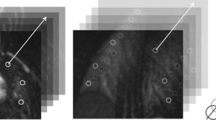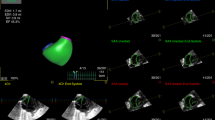Abstract
Background
Pulmonary arterial hypertension, impaired cardiac function and lung hypoplasia are common in infants with congenital diaphragmatic hernia (CDH) and are associated with increased morbidity and mortality. Robust noninvasive methods to quantify these abnormalities in early infancy are lacking.
Objective
To determine the feasibility of MRI to quantify cardiopulmonary hemodynamics and function in infants with CDH and to investigate left–right blood flow and lung volume discrepancies.
Materials and methods
We conducted a prospective MRI study of 23 neonates (isolated left CDH: 4 pre-repair, 7 post-repair, 3 pre- and post-repair; and 9 controls) performed on a small-footprint 1.5-tesla (T) scanner. We calculated MRI-based pulmonary arterial blood flow, left ventricular eccentricity index, cardiac function and lung volume. Using the Wilcoxon rank sum test for continuous data and Fisher exact test for categorical data, we made pairwise group comparisons.
Results
The right-to-left ratios for pulmonary artery blood flow and lung volume were elevated in pre-repair and post-repair CDH versus controls (flow: P<0.005; volume: P<0.05 pre−/post-repair). Eccentricity index at end-systole significantly differed between pre-repair and post-repair CDH (P<0.01) and between pre-repair CDH and controls (P<0.001).
Conclusion
Cardiopulmonary MRI is a viable method to serially evaluate cardiopulmonary hemodynamics and function in critically ill infants and is useful for capturing left–right asymmetries in pulmonary blood flow and lung volume.




Similar content being viewed by others
References
Kinsella JP, Ivy DD, Abman SH (2005) Pulmonary vasodilator therapy in congenital diaphragmatic hernia: acute, late, and chronic pulmonary hypertension. Semin Perinatol 29:123–128
Mohseni-Bod H, Bohn D (2007) Pulmonary hypertension in congenital diaphragmatic hernia. Semin Pediatr Surg 16:126–133
Okazaki T, Okawada M, Shiyanagi S et al (2008) Significance of pulmonary artery size and blood flow as a predictor of outcome in congenital diaphragmatic hernia. Pediatr Surg Int 24:1369–1373
Abolmaali N, Koch A, Gotzelt K et al (2010) Lung volumes, ventricular function and pulmonary arterial flow in children operated on for left-sided congenital diaphragmatic hernia: long-term results. Eur Radiol 20:1580–1589
Pierro M, Thébaud B (2014) Understanding and treating pulmonary hypertension in congenital diaphragmatic hernia. Semin Fetal Neonatal Med 19:357–363
Patel N, Lally PA, Kipfmueller F et al (2019) Ventricular dysfunction is a critical determinant of mortality in congenital diaphragmatic hernia. Am J Respir Crit Care Med 200:1522–1530
Hollinger LE, Buchmiller TL (2020) Long term follow-up in congenital diaphragmatic hernia. Semin Perinatol 44:151171
Peetsold MG, Heij HA, Kneepkens CM et al (2009) The long-term follow-up of patients with a congenital diaphragmatic hernia: a broad spectrum of morbidity. Pediatr Surg Int 25:1–17
Spoel M, Marshall H, Hanneke I, Parra-Robles J et al (2016) Pulmonary ventilation and micro-structural findings in congenital diaphragmatic hernia. Pediatr Pulmonol 51:517–524
Spoel M, van de Ven KP, Tiddens HAWM et al (2013) Lung function of infants with congenital lung lesions in the first year of life. Neonatology 103:60–66
Stefanutti G, Filippone M, Tommasoni N et al (2004) Cardiopulmonary anatomy and function in long-term survivors of mild to moderate congenital diaphragmatic hernia. J Pediatr Surg 39:526–531
Abraham S, Weismann CG (2016) Left ventricular end-systolic eccentricity index for assessment of pulmonary hypertension in infants. Echocardiography 33:910–915
Healy F, Lin W, Feng R et al (2015) An association between pulmonary hypertension and impaired lung function in infants with congenital diaphragmatic hernia. Pediatr Pulmonol 50:672–682
Mourani PM, Sontag MK, Younoszai A et al (2008) Clinical utility of echocardiography for the diagnosis and management of pulmonary vascular disease in young children with chronic lung disease. Pediatrics 121:317–325
Mourani PM, Abman SH (2013) Pulmonary vascular disease in bronchopulmonary dysplasia: pulmonary hypertension and beyond. Curr Opin Pediatr 25:329–337
Zussman ME, Bagby M, Benson DW et al (2012) Pulmonary vascular resistance in repaired congenital diaphragmatic hernia vs. age-matched controls. Pediatr Res 71:697–700
Higano NS, Fleck RJ, Spielberg DR et al (2017) Quantification of neonatal lung parenchymal density via ultrashort echo time MRI with comparison to CT. J Magn Reson Imaging 46:992–1000
Higano NS, Spielberg DR, Fleck RJ et al (2018) Neonatal pulmonary magnetic resonance imaging of bronchopulmonary dysplasia predicts short-term clinical outcomes. Am J Respir Crit Care Med 198:1302–1311
Critser PJ, Higano NS, Tkach JA et al (2020) Cardiac magnetic resonance imaging evaluation of neonatal bronchopulmonary dysplasia-associated pulmonary hypertension. Am J Respir Crit Care Med 201:73–82
Swift AJ, Rajaram S, Condliffe R et al (2012) Pulmonary artery relative area change detects mild elevations in pulmonary vascular resistance and predicts adverse outcome in pulmonary hypertension. Investig Radiol 47:571–577
Shehata ML, Harouni AA, Skrok J et al (2013) Regional and global biventricular function in pulmonary arterial hypertension: a cardiac MR imaging study. Radiology 266:114–122
Quail MA, Knight DS, Steeden JA et al (2015) Noninvasive pulmonary artery wave intensity analysis in pulmonary hypertension. Am J Physiol Heart Circ Physiol 308:H1603–H1611
Latus H, Kuehne T, Beerbaum P et al (2016) Cardiac MR and CT imaging in children with suspected or confirmed pulmonary hypertension/pulmonary hypertensive vascular disease. Expert consensus statement on the diagnosis and treatment of paediatric pulmonary hypertension. The European Paediatric Pulmonary Vascular Disease Network, endorsed by ISHLT and DGPK. Heart 102:ii30–ii35
Lee TC, Lim FY, Keswani SG et al (2011) Late gestation fetal magnetic resonance imaging-derived total lung volume predicts postnatal survival and need for extracorporeal membrane oxygenation support in isolated congenital diaphragmatic hernia. J Pediatr Surg 46:1165–1171
Alfaraj MA, Shah PS, Bohn D et al (2011) Congenital diaphragmatic hernia: lung-to-head ratio and lung volume for prediction of outcome. Am J Obstet Gynecol 205:43.e1–43.e8
Morini F, Valfre L, Capolupo I et al (2013) Congenital diaphragmatic hernia: defect size correlates with developmental defect. J Pediatr Surg 48:1177–1182
Lally KP, Lasky RE, Lally PA et al (2013) Standardized reporting for congenital diaphragmatic hernia — an international consensus. J Pediatr Surg 48:2408–2415
Tkach JA, Hillman NH, Jobe AH et al (2012) An MRI system for imaging neonates in the NICU: initial feasibility study. Pediatr Radiol 42:1347–1356
Tkach JA, Merhar SL, Kline-Fath BM et al (2014) MRI in the neonatal ICU: initial experience using a small-footprint 1.5-T system. AJR Am J Roentgenol 202:W95–W105
Merhar SL, Tkach JA, Woods JC et al (2017) Neonatal imaging using an on-site small footprint MR scanner. Pediatr Radiol 47:1001–1011
Hahn AD, Higano NS, Walkup LL et al (2017) Pulmonary MRI of neonates in the intensive care unit using 3D ultrashort echo time and a small footprint MRI system. J Magn Reson Imaging 45:463–471
Mosteller RD (1987) Simplified calculation of body-surface area. New Engl J Med 317:1098
Yamasaki Y, Nagao M, Kamitani T et al (2016) Clinical impact of left ventricular eccentricity index using cardiac MRI in assessment of right ventricular hemodynamics and myocardial fibrosis in congenital heart disease. Eur Radiol 26:3617–3625
McCrary AW, Malowitz JR, Hornick CP et al (2016) Differences in eccentricity index and systolic-diastolic ratio in extremely low-birth-weight infants with bronchopulmonary dysplasia at risk of pulmonary hypertension. Am J Perinatol 33:57–62
Higano NS, Hahn AD, Tkach JA et al (2017) Retrospective respiratory self-gating and removal of bulk motion in pulmonary UTE MRI of neonates and adults. Magn Reson Med 77:1284–1295
Schopper MA, Walkup LL, Tkach JA et al (2017) Evaluation of neonatal lung volume growth by pulmonary magnetic resonance imaging in patients with congenital diaphragmatic hernia. J Pediatr 188:96–102.e1
Zollner FG, Zahn K, Schaible T et al (2012) Quantitative pulmonary perfusion imaging at 3.0 T of 2-year-old children after congenital diaphragmatic hernia repair: initial results. Eur Radiol 22:2743–2749
Weis M, Zoellner FG, Hagelstein C et al (2016) Lung perfusion MRI after congenital diaphragmatic hernia repair in 2-year-old children with and without extracorporeal membrane oxygenation therapy. AJR Am J Roentgenol 206:1315–1320
Altit G, Bhombal S, Van Meurs K, Tacy TA (2018) Diminished cardiac performance and left ventricular dimensions in neonates with congenital diaphragmatic hernia. Pediatr Cardiol 39:993–1000
Acknowledgments
The authors would like to acknowledge and thank Erin Watters for her patient recruitment efforts. This work was supported by the Cincinnati Children’s Research Foundation (Research Innovation and Pilot Fund and Academic and Research Committee Fund); authors J.C. Woods and N.S. Higano were supported in part by NIH R01 HL146689. Subsets of this work were presented at the 24th Annual Meeting & Exhibition of the International Society for Magnetic Resonance in Medicine (ISMRM), Singapore, May 7–13, 2016, and at the American Thoracic Society International Conference, Washington, DC, May 19–24, 2017.
Author information
Authors and Affiliations
Corresponding author
Ethics declarations
Conflicts of interest
None
Additional information
Publisher’s note
Springer Nature remains neutral with regard to jurisdictional claims in published maps and institutional affiliations.
Rights and permissions
About this article
Cite this article
Tkach, J.A., Higano, N.S., Taylor, M.D. et al. Quantitative cardiopulmonary magnetic resonance imaging in neonatal congenital diaphragmatic hernia. Pediatr Radiol 52, 2306–2318 (2022). https://doi.org/10.1007/s00247-022-05384-w
Received:
Revised:
Accepted:
Published:
Issue Date:
DOI: https://doi.org/10.1007/s00247-022-05384-w




